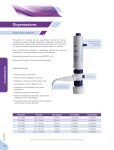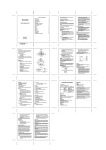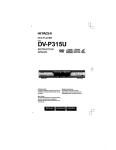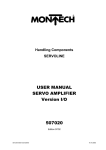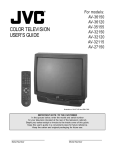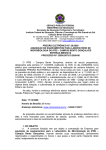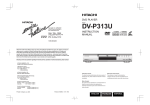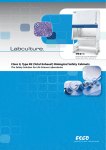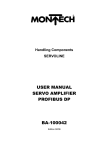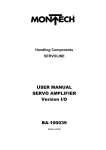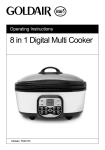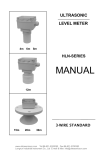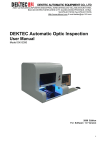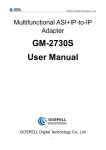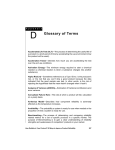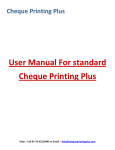Download A.2 Environmental Specification
Transcript
© 2012-2013 Shenzhen Biocare Bio-Medical Equipment Co., Ltd. All rights reserved. For this User’s Manual, the issue date is May 2013. Version:2.0 I Intellectual Property Statement SHENZHEN BIOCARE BIO-MEDICAL EQUIPMENT CO., LTD (hereinafter called Biocare bio-medical) owns the intellectual property rights to this product and this manual. This manual may refer to information protected by copyright or patents and does not convey any license under the patent rights or copyright of Biocare bio-medical or of others. Biocare bio-medical intends to maintain the contents of this manual as confidential information. Disclosure of the information in this manual in any manner whatsoever without the written permission of Biocare bio-medical is strictly forbidden. Release, amendment, reproduction, distribution, rental, adaptation, translation or any other derivative work of this manual in any manner whatsoever without the written permission of Biocare bio-medical is strictly forbidden. is the trademark, registered or otherwise, of Biocare bio-medical in China and other countries. All other trademarks that appear in this manual are used only for informational or editorial purposes. They are the property of their respective owners. II Responsibility on the Manufacturer Party Biocare bio-medical reserves the final interpretation for this User’s Manual. Biocare bio-medical reserves the rights to modify the User’s Manual without further notice. The modified parts will be present in the new edition of User’s Manual. Biocare bio-medical is not responsible for any software and devices provided by non Biocare bio-medical and distributors. Biocare bio-medical is responsible for the product safety, reliability and performance on condition that all the following conditions are satisfied: Installation, expansion, readjustment, improvement and maintenance must be operated by professionals authorized by Biocare bio-medical. All maintenance involving replacement of spare parts and its accessories, consumables should use the original sets or sets authorized by Biocare bio-medical. Relevant electrical equipment meets national standards and requirements of this User’s Manual. Please operate the product as per the User’s Manual. WARNING z The device must be operated by professional clinicians or under the guidance of professional clinicians. The users must receive adequate product training. No unauthorized or untrained personnel should carry out any operation. III Warranty THIS WARRANTY IS EXCLUSIVE AND IS IN LIEU OF ALL OTHER WARRANTIES, EXPRESSED OR IMPLIED, INCLUDING WARRANTIES OF MERCHANTABILITY OR FITNESS FOR ANY PARTICULAR PURPOSE. Exemptions Biocare bio-medical's obligation or liability under this warranty does not include any transportation or other charges or liability for direct, indirect or consequential damages or delay resulting from the improper use or application of the product or the use of parts or accessories not approved by Biocare bio-medical or repairs by people other than Biocare bio-medical authorized personnel. This warranty shall not extend to: Malfunction or damage caused by improper use or man-made failure. Malfunction or damage caused by unstable or out-of-range power input. Malfunction or damage caused by force majeure such as fire and earthquake. Malfunction or damage caused by improper operation or repair by unqualified orunauthorized service people. Malfunction of the instrument or part whose serial number is not legible enough. Others not caused by instrument or part itself. IV Company Contact Manufacturer: Shenzhen Biocare Bio-Medical Equipment Co., Ltd. Factory: 2/F West, 4th Block, Dayang Road South, Fuyong Sub-district, Bao’an District, 518103 Shenzhen, PEOPLE’S REPUBLIC OF CHINA Headquarters: #A735, 7/F, Block A, Shenzhen Mingyou Industrial Products Exhibition & Procurement Center, Baoyuan Road, Xixiang Sub-district, Bao’an District, 518102 Shenzhen, PEOPLE’S REPUBLIC OF CHINA Website: http://www.biocare.com.cn Tel: 0086-755-27960888 Fax: 0086-755-27960643 EC-Representative: Shanghai International Holding Corp. GmbH (Europe) Address: Eiffestraße 80,20537 Hamburg GERMANY V Preface Manual Purpose This User’s Manual describes the product’s application, function and operation in details. Please read this User’s Manual carefully and understand the content before use to ensure the proper usage and guarantee the safety of the patient and the user. This User’s Manual describes the product as per the most complete configuration. Some content of this manual may not be applicable for the product on your hand. Please contact us for any questions. Please keep this User’s Manual beside the infusion pump in order to consult it conveniently. Intended Audience This User’s Manual is only applicable for well-trained clinical people. Illustrations All illustrations in this User’s Manual are used for reference only. Its settings or data may be not entirely consistent with the actual displayed info on the product. Conventions Italic text is used in this manual to quote the referenced chapters or sections. The terms danger, warning, and caution are used throughout this manual to point out hazards and to designate a degree or level of severity. VI Contents 1 Safety .................................................................................................................. 1-1 1.1 Safety Information............................................................................................. 1-1 1.1.1 Dangers ................................................................................................ 1-1 1.1.2 Warnings ............................................................................................... 1-2 1.1.3 Cautions................................................................................................ 1-4 1.1.4 Notes..................................................................................................... 1-5 1.2 Equipment Symbols .......................................................................................... 1-6 2 The Basics .......................................................................................................... 2-1 2.1 Product Introduction.......................................................................................... 2-1 2.1.1 Application Scope ................................................................................. 2-1 2.1.2 Contraindications .................................................................................. 2-1 2.1.3 Product Structure, Composition and Performance ................................ 2-1 2.2 Appearance....................................................................................................... 2-3 2.2.1 Front Panel ........................................................................................... 2-3 2.2.2 Back Panel............................................................................................ 2-5 2.3 Screen Displaying ............................................................................................. 2-6 2.4 Battery .............................................................................................................. 2-6 2.4.1 Overview ............................................................................................... 2-6 2.4.2 Battery Guidelines................................................................................. 2-7 2.4.3 Battery Maintenance ............................................................................. 2-8 2.4.3.1 Conditioning a Battery ........................................................... 2-8 2.4.3.2 Checking a Battery ................................................................ 2-8 2.4.4 Battery Recycling .................................................................................. 2-9 3 Installation and Maintenance ............................................................................ 3-1 3.1 Installation......................................................................................................... 3-1 3.1.1 Out of Box Audit(OOBA) ....................................................................... 3-1 3.1.2 Environmental Requirements ................................................................ 3-2 3.1.3 Power Supply Requirements................................................................. 3-2 3.1.4 Fix Infusion Pump ................................................................................. 3-3 3.1.5 Install Power Cord................................................................................. 3-4 3.1.6 Installation of Drop Sensor (Optional) .............................................. 3-4 3.2 Maintenance ..................................................................................................... 3-6 3.2.1 Inspection.............................................................................................. 3-6 3.2.2 Cleaning................................................................................................ 3-6 3.2.3 Preventive Maintenance........................................................................ 3-8 3.2.4 Pollution-Free Treatment and Recycling ............................................... 3-8 4 Operation Guide................................................................................................. 4-1 4.1 Operation Flow Chart ........................................................................................ 4-1 1 4.2 Operation Steps ................................................................................................ 4-2 4.2.1 Start Infusion Pump............................................................................... 4-2 4.2.2 Install the Infusion Tube ........................................................................ 4-3 4.2.3 Setting Infusion Parameters.................................................................. 4-4 4.2.4 Clearing Accumulated Volume .............................................................. 4-5 4.2.5 Starting Infusion .................................................................................... 4-5 4.2.6 Infusion Completed ............................................................................... 4-5 4.2.7 Shutdown .............................................................................................. 4-6 5 Function and Interface ...................................................................................... 5-1 5.1 Infusion Mode and Parameter Setting............................................................... 5-1 5.1.1 Setting Flow Rate.................................................................................. 5-2 5.1.2 Setting Preset Volume........................................................................... 5-3 5.1.3 Setting Other Parameters ..................................................................... 5-3 5.2 Advanced Setting .............................................................................................. 5-4 5.3 Unlocking .......................................................................................................... 5-5 5.4 Starting Bolus Function (Bolus)......................................................................... 5-6 5.5 Pressure Sensor Calibration ............................................................................. 5-6 5.6 Changing Infusion Tube Brand.......................................................................... 5-8 5.6.1 Selection of IV Set................................................................................. 5-8 5.6.2 Setting Infusion Accuracy...................................................................... 5-9 5.6.3 Setting Occlusion Level....................................................................... 5-10 5.6.4 Setting Air Bubble Filter Level ............................................................. 5-11 5.7 Drop Rate Function (Optional) ........................................................................ 5-11 5.7.1 Starting Drop Rate Function................................................................ 5-12 5.7.2 Setting Drop Rate for infusion tube ..................................................... 5-12 5.8 Language Switching........................................................................................ 5-13 6 Alarms................................................................................................................. 6-1 6.1 Overview ........................................................................................................... 6-1 6.2 Alarm Type ........................................................................................................ 6-1 6.2.1 Audible Alarm ........................................................................................ 6-1 6.2.2 Alarm Information .................................................................................. 6-1 6.3 Alarm Countermeasures ................................................................................... 6-2 A Product Specification....................................................................................... A-1 A.1 Safety Specification ..........................................................................................A-1 A.2 Environmental Specification..............................................................................A-1 A.3 Power Supply Specification ..............................................................................A-2 A.4 Hardware Specification.....................................................................................A-2 A.5 Basic Parameters of Infusion Pump .................................................................A-3 A.6 Pressures that trigger a occlusion alarm, maximum alarm delays, and permissible maximum volumes per infusion...............................................................................A-4 A.7 Infusion Accuracy Table ....................................................................................A-5 2 B EMC GUIDANCE AND MANUFACTURER’S DECLARATION ......................... B-1 C Alarm Information............................................................................................. C-1 C.1 Alarm Information ............................................................................................ C-1 C.2 Prompt Message ............................................................................................. C-4 D Symbols and Terminology............................................................................... D-1 D.1 Units ................................................................................................................ D-1 D.2 Terminology ..................................................................................................... D-2 3 FOR YOUR NOTES 4 1 Safety 1.1 Safety Information The safety statements presented in this chapter refer to the basic safety information that the operator shall pay attention to and abide by. There are additional safety statements in other chapters or sections, which may be the same as or similar to the followings, or specific to the operations. DANGER z Indicates an imminent hazard that, if not avoided, will result in death or serious injury. WARNING z Indicates a potential hazard or unsafe practice that, if not avoided, could result in death or serious injury. CAUTION z Indicates a potential hazard or unsafe practice that, if not avoided, could result in minor personal injury or product/property damage. NOTE z Provides application tips or other useful information to ensure that you get the most from your product. 1.1.1 Dangers There are no dangers that refer to the product in general. Specific ‘Danger’ statements may be given in the respective sections of this manual. 1-1 1.1.2 Warnings WARNING z This infusion pump is used for clinic infusion, and it can only be used by professional clinicians, medical electrical experts, or well- trained nurses on specific occasions. z Infusion pump and its accessories must be inspected before use to guarantee its normal and safe operation. z Avoid using this infusion pump in the flammable or explosive atmosphere in case of fire outbreak or explosion. z Infusion alarms must be set based on the actual situation of the patients. Do not rely too much on the audible alarm system in the infusion supervision. Pay close attention to the actual clinical situation of the patient. z Keep observing the remained liquid volum in infusion bags (or infusion bottles) and check if there is any air bobble in infusion tubes during the infusion. Do not rely on the alarm function of the infusion pump only. z The pressure detector may not work normally in high-pressure environment, especially in hyperbaric oxygen therapy. z Making sure the blood vessel is well protected before infusion. z In the infusion tube, the occlusion caused by tube knot and murphy’s dropper coagulation or intubations may lead to the rise of the inner pressure of the infusion tube. At this moment, the effort to eliminate the occlusion may cause too much liquid to be infused into the patient’s body with a large dose. Proper measures should be taken to prevent this phenomenon. For example, to clamp the infusion tube before occlusion elimination. z This infusion pump should be used 120 CM above or below the patient’s heart. z Avoid using the infusion pump when there is any alarm. z When another set of infusion system or accessories is connected to the infusion tube used in this infusion pump, the operation of this pump may not meet its specifications. z Only standard components, connectors and disposable products can be used with this pump. Subsidiary items are not allowed to be attached to the pump and its accessories. Reconstruction of the pumps is not allowed. 1-2 z The accuracy will not be maintained when the pump is used with the non-standard infusion tube or the parameters of the infusion tube are not set accurately. The maximum deviation may reach 40% or above. z Disposable accessories must be disposed after use in accordance with the relevant regulations of the hospital. z This infusion pump belongs to Class II (type of electric shock protection), the supplied Type I power cord PE earth terminal should not be used as ground protection and functional earthing. z Do not open the case of the infusion pump, otherwise there might be electric shock. The infusion pump must be maintained or updated by maintenance staff trained and authorized by our company. z Packing materials must be disposed in accordance with the relevant local statutes or the waste disposal regulations of the hospital. They must be kept out of the reach of children. z The double thickness of the infusion tube should be between 0.8mm-1.2mm. Outer diameter should be between 3.5mm-4.5mm. Otherwise, its accuracy can not be guaranteed, which may cause severe injury to patients. 1-3 1.1.3 Cautions CAUTION z Please use the accessories specified in this User’s Manual to gurantee the safety of the patient. z Cables must be connected carefully to reduce the possibility of the patient getting intertwined or choked. z Disposable accessories can only be used once. Reuse may lead to declined performance or cross-infection. z When installation of the infusion tube is completed, please observe whether there is leakage before the infusion. If any leakage the machine should be examined and processed immediately. z Replace the fixing place of the infusion tube every 4 hours after starting infusion to guarantee the accuracy. Replace the infusion tube after the infusion lasting for 24 hours. z This infusion pump or its accessories must be disposed in accordance with local statutes or hospital regulations after its operating life. Please contact the distributor that sells the product to you or the manufacturer if there is any inquiry. z Electromagnetic field may influence the performance of the infusion pump. Therefore, equipments or devices used near the infusion pump must meet the EMC standard. Mobile phones, X ray or MRI equipments are all potential interference sources because of their high-intensive electromagnetic radiation. z Avoid the direct sunshine, high temperature or humidity. z Avoid exposing this infusion pump to high-pressure sterilization or chemical materials. z Check the built-in battery before use to make sure the power is enough. Recharge the battery if necessory. z Before the infusion pump is connected to the power supply, make sure the voltage and frequency of the power supply meet the label of the pump or the specific requirments in this User’s Manual. z Please install and carry the infusion pump appropriately to protect the pump from drop, impact, strong oscillation or other damage caused by machinery external force. z Use a piece of wet soft cloth with warm water to wipe the surface of the infusion pump when there is any liquid on. 1-4 z If the surface tention, proportion and viscosity of the infusion solution is different from saline (for example, a kind of solution mixed with surface activite agent), the infusion accuracy may be different from the accuracy listed in the specifications table. z When the infusion rate is high (≥ 1000ml/h), high-quality silicone tubes with 0.9mm transfusion needles must be used with the pump to keep the infusion accuracy. z If the infusion pump fails to work as specified in the User’s Manual due to any uncertainty, please stop infusion, and report the situation (including infusion accessories used with the pump, infusion volume, infusion rate, SN, liquid type, etc.) to your supplier or our company. z The drop sensor is not applicable for light-proof medicine infusion. Adopting light-proof IV sets on the pumps might cause failure operating of drop sensor and sever damage to the patients. 1.1.4 Notes NOTES z Please keep this User’s Manual along with the infusion pump for the convenient and timely reference. z Please install the infusion pump to the place convenient for observation, operation and maintenance. z This User’s Manual describes all the configuration and functions of the infusion pump. The infusion pump you bought may not have some of the configuration or functions. z Please do not insert devices which are not specified by our company to the data interface. z The SN of this infusion pump has been set. Users are not allowed to change it. 1-5 1.2 Equipment Symbols Note! Please refer to the User’s Manual Class II Equipment Type BF applied parts Prevented against dripping water Alternating Current Power Supply (AC) Direct Current Power Supply (DC) Batch No. Serial No. Date of Production Manufacturer Pollution-Free Treatment Wireless transceiver Upward or Add Value Downward or Reduce Value Turn on Turn off Fragile items, handle with care Transport package fear of rain The same packing stacked up to 5-layers Transport should be straight up Authorised Representative in the European Community. The CE mark is a protected conformity mark of European Community.The products herewith comply with the requirements of the Medical Device Directive 93/42/EEC 1-6 2 The Basics 2.1 Product Introduction 2.1.1 Application Scope This infusion pump is used in wards, operation rooms, and observation rooms for accurate and continuous infusion to patients. Any institutes or units, such as hospital outpatient, emergency rooms, wards, operation rooms, observation rooms, clinics, nursing home, etc., capable enough to provide health care, is expected to use this infusion pump. WARNING z Check the infusion pump and its accessories before use to ensure its normal and safe operation. CAUTION The operation environment and power supply of this infusion pump must meet the requirments in A. Product Specification. z 2.1.2 Contraindications None 2.1.3 Product Structure, Composition and Performance iP 12B Infusion Pump consists of the shell, pump device, the board card and battery, etc. iP 12B Infusion Pump contains the following parts: Microcomputer System: the core of the whole system, which gives intellectualized control and management over the whole system and processes detection signals. In this system, two single-chip Micyoco (SCM) systems are adopted for mutual backup copy and supervision. When one SCM goes wrong, the other one will give a timely warning signal and cut the power of the host 2-1 computer to stop the pump with the purpose to ensure the patient’s safety. Pump Device: the power source of infusion,employs step motor to drive the pump tablets continuously extruding upon infusion tube to materialize infusion. Detection Device: the device mainly includes all kinds of sensors, like air bubble sensor (detect air bubble inside the infusion tubes), pressure sensor (detect the pressure inside the infusion tube), etc. Alarm Device: the device mainly includes audible alarms and information alarms, drawing the user’s attention to the correct operation. Input and Display Device: the input device is in charge of setting infusion parameters, such as flow rate, etc. And the display device is in charge of displaying all the parameters and the current working status on the screen. Built-in Battery: the battery sustains the operation of the infusion pump when there is no AC power supply. The performance of iP 12B Infusion Pump: Accurate control of flow rate. Accurate control of infusion volume. Accurate control of infusion time Timely alarms for air bubble, infusion Over, occlusion, low battery, infusion tube installation error, and control abnormal, etc. Provide multi-infusion modes :drop sensor mode (optional), rate mode, time mode, body weight mode. 2-2 2.2 Appearance 2.2.1 Front Panel 1. AC lamp While the pump is turned off and the lamp is on, it indicates AC power supply. 2. Running indicator lamp The lamp is on and flashes during infusion when the infusion tube is properly installed. 3. Pressure diagram To reflect the current inside pressure of the infusion tube. 4. Upward/ value-increase key Select needed parameter or increase the values. 5. CLEAR key 2-3 Press this key to clear accumulated value under stop status. 6. Infusion mode Display current infusion mode. 7. Value Increment It could be used under value setting status. 8. Type of infusion tube Display current type of infusion tube ( A,B,C). 9. Status Icon Display current infusion status: Stop, Run, KVO, Bolus. 10. Power icon indicate the current power status: When machine connect to AC power and battery is full capacity, LCD displays ‘plug’. When machine connect to AC power and battery is not full capacity, LCD display battery charging icon. When machine disconnect to AC power, LCD display battery icon and its current battery capacity. 11. Door Lock Pull up the door lock: to install or take off the infusion tube. Push down the door lock: to tightly clamp the tube. The running indicator lamp is on if infusion tube is well installed when the door lock was pushed down. 12. Downword/ value-decrease key Select needed parameter or decrease the values. 13. Confirm key Put the parameters into an adjustable condition or save the parameters. 14. SET key To select infusion mode. 15. START/ BOLUS In stop status, if the infusion tube is correctly installed, press this key to start infusion. During infusion process, keep pressing this key to start bolus function. If the flow rate is less than settled bolus rate, the pump shall infuse at 1000ml/h (when flow rate ≤1000ml/h). After removing your finger from the key, it will return to its original infusion rate. 16. STOP / ELIMINATE Alarm key In running status, press this key to stop infusion. When the alarm is on, press this key to eliminate the alarm (except for low battery alarm). In value inputting status, press this key to resume the original value and quit. 17. POWER key Turn on the machine:Press this key for more than 2 seconds. Turn off the machine:Press this key for more than 4 seconds. 18. SELECT Key When setting the value by or key, press this key to select the incremental value : 0.1、1、10、100、1000. Some parameters setting can only select incremental value: 1、10、100、1000. 2-4 2.2.2 Back Panel 1. 2. 3. 4. 5. Power tab Power socket Drop sensor socket (drop sensor is an optional accessory) Fixing Clamp Product label 2-5 2.3 Screen Displaying This pump is equipped with LCD screen. The displayed information contains four major parts: 1. Title Bar To display current functional modes, incremental value and type of infusion tube. 2. Information Zone To display various parameters of current infusion mode 3. Status Bar To display infusion pump alarm information, pressure status, power supply and infusion status. 2.4 Battery 2.4.1 Overview The infusion pump uses built-in rechargeable battery to guarantee the normal use of the pump during patients transfer or electricity fails in hospital. The battery will charge itself automatically once the pump is connected to the AC power and in Power on situation. The pump shall work with its battery in case of sudden electricity break down. The battery shall provide the power for normal operation of the pump for a certain while, once the battery capacity reaches the lowest voltage, the pump will trigger a low voltage alarm every few seconds to notice the users; after a certain while, the pump shall trigger a serious low battery alarm with the battery indicator lamp flashes and a rapid and short alarming sound. If the pump is working at this time, it will stop infusion automatically and will not work until it is connected to the AC power. The low battery alarm will be eliminated only after the pump is connected to the AC power. 2-6 WARNING z Keep the battery out of the reach of children. z Use only the battery specified by the manufacturer. NOTE z When the battery capacity is 0 and in low battery condition, an alarm will be triggerd within a few seconds to remind the users of low battery. Shortly after low battery alarm, the pump shall trigger a serious low battery alarm, the indicator lamp shall flash and the pump will give a rapid and short alarming sound. If the pump is in working status, it will stop infusion automatically and it can not be used for infusion until it is connected to the AC power. The serious low battery alarm will be eliminated when the pump is connected to the AC power. z 8-14 hours will be needed to fully charge the battery. z Please discharge the battery every three months to prevent damage of the battery if the product is not used very often. z Battery is a consumable part. Please replace it when it is exhausted. z In case the battery needs to be changed, please contact the local distributor or manufacturer. 2.4.2 Battery Guidelines The life span of the battery depends on its usage frequency and environment. If proper usage and maintenance are adopted, its life span is 3 years. Otherwise, its life span will be deducted. The battery shall be replaced every 3 years. For safety usage and capably extend a longer battery life, please follow the battery instruction: Annual battery inspection is needed. Before the pump is sent for maintainance purpose or you doubt the battery is the causing reason, the battery checking is needed. Optimize the battery every three months of use (or storage), or once the running hours of battery is significantly shortened. Using 1C current (1C current shall be larger than the working current of the working plate, the max charging current of the protection plate is the working current of protection plate) 8.4V voltage limiting to charge the battery for 0.5hour in order to guarantee the battery is stored with electricity. 2-7 WARNING z Using the battery provided by the manufacturer. z Please replace the battery once the battery is damaged or leaks z Damaged battery shall not be used z The used battery shall be returned to the distributor or manufacturer, or be disposed according to applicable laws. 2.4.3 Battery Maintenance 2.4.3.1 Conditioning a Battery Optimize the battery when it is used for the first time. A complete optimizing cycle includes: continuously charging until the battery is fully charged, then discharge the battery until the pump powered off automatically. Then charge the battery continuously again. During the usage, a regular optimize battery performance will extend its life span. NOTE z The actual battery capacity will reduce after the battery is used for some time. If the battery capacity is shortened obviously during optimizing, please replace the battery. Please follow the steps below during optimizing: 1. Disconnect the infusion pump the patients, stop the infusion. 2. Connect the infusion pump to the AC power, charging continuously for 12 hours. 3. Disconnect the infusion pump and the AC power, using the battery as the power supply until the infusion pump powered off automatically. 4. Connect the infusion pump to the AC power, charging continuously for 12 hours 5. Optimizing battery performance is completed. 2.4.3.2 Checking a Battery Regular check for the battery is needed due to the reason that the battery function will decrease during usage. Please follow the steps below when checking battery function 1. Connect the pump to the AC power, charging continuously for 8 to 14 hours. 2. Disconnect the AC power supply and let the machine work on battery until it is turned off due to battery exhausting. If the battery works for over 200 minutes, the battery is in fine condition. If the battery works for 60 to 200 minutes, the battery is close to the end of its life. If the battery works less than 60 minutes, the battery needs to be replaced. 3. Please charge the battery for future usage after checking. 2-8 NOTE z If the using time of the battery is too short after full-charge, there might be a damage of the battery. The power supply time of the battery depends on the using frequency of the pump and its setting parameters. E.g. the display is in backlight mode. z If the battery has obvious damage (deformation, bumps, leakage) or can not reach the capacity, it should be replaced and recycled. 2.4.4 Battery Recycling If the battery has obvious damage (deformation, bumps, leakage) or can not reach the capacity, it should be replaced and recycled. Please follow the applicable laws during recycle. WARNING z The battery must not be disassembled, thrown into fire or short circuited. The burning, explosion and leakage of the battery may cause personal injury. 2-9 FOR YOUR NOTES 2-10 3 Installation and Maintenance 3.1 Installation WARNING z The software copyright of this infusion pump belongs to our company. Any infringement act such as falsification, reproduction or exchanging by any means or in any form by any organization or individual is not allowed without permission. 3.1.1 Out of Box Audit(OOBA) Before opening the box, please check the package carefully to find if there is any damage to the products during transportation. If there is any damage, please contact the forwarder or our company immediately. If the package is intact, please open the package in right way, take out the infusion pump and its accessories with care, and check them out in accordance with the packing list. Please examine if there is any mechanical damage to the pump and whether the package includes all things on the packing list. Please contact our customer service department immediately if there is any inquiry. WARNING z Please keep the packing materials out of the reach of children. The packing materials must be disposed in compliance with the local laws and regulations or the hospital policy on waste treatment. NOTE z Please keep the packing case and packing materials for the future use. z Please contact the sales agent or our company if any of the spare parts is missing when you open the package. 3-1 3.1.2 Environmental Requirements The service environment of this infusion pump must meet the requirements in A.2 Product Specifications. The service environment of this infusion pump should also be appropriately protected from noise, vibration, dust, or corrosive, inflammable or explosive, Substances. There should be 2 inch (5cm) interspace around the infusion pump to make sure the air moves freely. When the infusion pump is transferred from one place to another, the difference in temperature and humidity may cause condensation to the infusion pump. In this case, please do not turn on the pump until there is no condensation. 3.1.3 Power Supply Requirements The power supply of this infusion pump must meet the requirements in A.3 Product Specifications. WARNING z Make sure the working environment and power supply meet the environmental requirement and the power supply requirement listed above. Otherwise, the infusion pump will not meet the technical specifications claimed in A Product Specifications, and it may also cause the unexpected consequence such as device damage. z The power supply must be selected in accordance with the settings of the system power voltage. Otherwise, it may cause sever damage to the system. 3-2 3.1.4 Fix Infusion Pump [Figure 3-1] Direction for fixing infusion pump as shown in Figure 3-1: 1. Steel tube of infusion pump stand 2. Screw of clamp [Figure 3-2] [Figure 3-3] 3-3 Steps to install infusion pump to infusion pump stand: As shown in Figure 3-2, for convenience, counter-clockwise twist the clamp knob and make enough room for the installation of the pump on the stand. As shown in Figure 3-3, place the stand at a position corresponding to the clamp, and then twist the clamp knob clockwise till the infusion pump installed well on the stand. NOTE z The infusion pump must be put horizontally. z Please make sure the stability of stand before installation. 3.1.5 Install Power Cord Plug the power cord into the AC power cord inlet. NOTE z Applicable power supply scope is 100-240V~, 50/60HZ. z A.C power cord should be inserted properly and tightly. 3.1.6 Installation of Drop Sensor (Optional) NOTE z This section has to be used with the optional Drop Sensor. The user may skim over the instruction in the section, if Drop Sensor is not equipped with the infusion pump. z The Drop Rate function can be started only when the rate≤400ml/h. 3-4 [Figure 3-4] [Figure 3-5] 1. Firmly insert the power cord of Drop Sensor to the connecting port on the rear panel, and make sure the volume of the liquid to be filtered less than 1/3 that of the liquid filter at meantime. 2. As shown in Figure 3-5, the Drop Sensor to be clipped to the liquid filter (the direction of pressure by hand as shown in Figure 3-4) must be over the liquid interface. NOTE z The liquid interface in the filter must be lower than the Drop Sensor. z The positioning block of the filter must be vertically inserted through the positioning groove of the Drop Sensor. z The infusion tube/pipe must be changed by a new one after continuously working over 24 hours. z Do not incline the drop rate sensor, or expose it to sunshine during infusion. z Make sure that the medicine liquid filter is not clamped too tightly by the drop rate sensor. 3-5 3.2 Maintenance WARNING z The hospital or medical establishment using this infusion pump must set up a complete maintenance plan. Otherwise, it may cause device failure or some unexpected consequence, and even threaten the personal safety. z All the safety inspection or the maintenance work which involves the disassembling the device must be proceeded by the professional maintenance personnel. The operation of any unqualified people may cause device failure and even threaten the personal safety. z Please contact the distributor or our company immediately if you find any problem of the pump. 3.2.1 Inspection The pump must be given an overall inspection before use, after 6~12 months’ continuous use, or after maintenance or updating to ensure the normal operation and work. The inspection standards are: The environment and power supply meet the requirements. The battery performance. The power cord has no abrasion and is well performed in electric insulation. Pass the leakage current test. The devices and accessories have no mechanical damage The accessories used with the pump are specified. The alarm system is well functioned. No leakage after installation of the infusion tube. The pump works well under all infusion modes. If there is any pump damage or abnormal phenomena, please do not use the infusion pump, and immediately contact the distributor or our company. 3.2.2 Cleaning The pump must be cleaned or disinfected with the materials and methods listed in this chapter. Otherwise, our company will not take the responsibility for any damage or accident caused by the cleaning and disinfection with other materials and methods. 3-6 Our company will not take any responsibility for the effectiveness of the infection control with the following chemicals or methods. Please contact the infection prevention department of the hospital or epidemic experts for the method of infection control. Please keep your devices and accessories away from the dust, and comply with the following provisions to prevent the device damage: Please dilute the cleanser and disinfectant in accordance with the manufacturer’s indication, or with their concentration as low as possible. Do not submerge the pump in the liquid. Do not dump the liquid on the device or its accessories. Prevent liquid from the pump body. Do not use the abrasive material (such as steel wool or silver polishing agent) and any strong dissolvant similar to acetone and acetone to prevent outer shell damaged. WARNING z Please turn off the power and disconnect the AC power supply before cleaning the device. CAUTION z Please turn off the power and disconnect the AC power supply before cleaning the device. If the liquid is dumpted on the infusion pump or its accessories by accident and make the infusion pump not work; please contact with the agent or manufacturer. The device should be cleaned regularly. The cleaning frequentness should be improved in areas with serious environmental pollution or heavy wind and sand. Please consult or refer to the specific regulations about device cleaning in the hospital. The recommended cleansers are: Warm water Diluted soap water Diluted aqua ammonia Sodium hypochlorite (bleaching power for washing) Hydrogen peroxide (3%) Ethanol (70%) Isopropanol (70%) 3-7 When cleaning the device: 1. Turn off the power, and disconnect the power cord. 2. Wipe the case with soft cotton balls adsorbing the cleanser. 3. Wipe the surface of the device with soft cloth adsorbing 75% of alcohol. 4. Keep the device in the cool and ventilated environment to dry up. The above steps are for reference only. Disinfection effects should be checked with the correct method. CAUTION z Do not use gas (EtO) or formaldehyde for sterilization. 3.2.3 Preventive Maintenance 1. Check the Infusion Rate Using measuring cylinder and stopwatch to check the infusion volume for every 6 month. 2. Maintain the Battery Performance Please refer to 2.4.3 Battery Maintenance Regular Maintenance Interval Routine Maintenance Procedures According to the hospital policy Thoroughly clean the feeding pump shell before or after long period of storage. Check to the pump at least once a year. 1. Check the AC power plug and power cord. 2. Run the machine until it gives a low battery alarm. Then charge the battery to ensure it works and recharge well. 3. Check if the machine leakage after correct installation of IV set 3.2.4 Pollution-Free Treatment and Recycling The service life of this product is 3 years. The pump exceeding its service life should be discarded. Please contact the manufacturer or distributor for more relevant information. You can make the following treatments: 1. iP 12B infusion pump that has been scrapped could be sent back to its distributors or manufacturer for proper recycling. 2. Used-up lithium polymer batteries could be delivered to its distributor or manufacturer for disposition, or treated according to corresponding regulations. 3-8 4 Operation Guide 4.1 Operation Flow Chart Fix the infusion pump Fix the infusion pump on the stable infusion tube stand; Start the infusion pump Press the key Install infusion tube Fix the infusion tube to the groove bottom of the pump straightly, and check if there is any leakage after well installation of the infusion tube; Set infusion parameter ; Press the key to set parameter. See Chapter 5 Function and Interface; Press the key to infusion firstly and then the key Eliminate air bubble from tube after air bubble eliminated from infusion tube; Clear accumulated volume Insert infusion accessories into patient Start infusion Infusion completed Shut down the infusion pump Press the key ; Connect infusion accessories to patient; Press the key ; Press the key ; Press the key . 4-1 4.2 Operation Steps NOTE z Part of this section covers the function of Drop Sensor. If the user needs to use this function, it is necessary to choose Drop Sensor as accessory to the infusion pump. For more details, please consult the distributor that sells the product to you or the manufacturer. 4.2.1 Start Infusion Pump After fixing the pump, please take the following steps to turn on the machine: 1. Please refer to 3.2.1 Inspection to make safety inspection before turn on the pump 2. Press the key . The pump will start self-checking. LCD will display the software version and the machine will play the start-up music of di….... 3. The infusion pump starts self-checking. 4. After a few seconds, the pump will finish the self-checking and enter the rate mode interface 5. Now user can operate the pump by keypad and panel NOTE z Symbol of power plug displayed on LCD means that the pump is supplied by A.C power. z Press the key is turned on. z The battery can be recharged only when the machine is connected to AC power and the machine is turned on. to open or close backlight of LCD when the pump 4-2 4.2.2 Install the Infusion Tube (1) Pull out the door lock as the arrowhead’s. (2) Pull straight the infusion tube. Install the two ports of infusion tube to the bottoms of the pump groove. (3) Place the infusion tube to the bottom of the pump groove straightly and horizontally. 4-3 (4) Pull down the door lock after installation. WARNING z Pull down the door lock after installation of infusion tube properly when the pump is on. When green indicator lamp is on, it means the infusion tube is proper installation. Otherwise, infusion tube need reinstallation. z When use the same infusion tube, change the part of pipe installed in groove of machine every 4 hours. The IV set should be discarded after 24 hours of continuous using. z Infusion tube is loose or pulled too tightly, which may cause abnormal infused volume. z The double thickness of the infusion tube should be between 0.8mm-1.2mm. Outer diameter should be between 3.5mm-4.5mm. Otherwise, its accuracy can not be guaranteed, which may cause severe injury to patients. CAUTION z After installation of infusion tube and before infusion, please check if there is any leakage. If so, please check the machine and installation of pipe. 4.2.3 Setting Infusion Parameters 1. Press the key to make the pump in stop condition. 2. Press the key to enter setting interface of infusion parameters. Press the key or to select the setting items. Then press the key make the setting item adjustable. Now press the key value, press the key or to to adjust the to save the parameter latest setting. NOTE z In the body weight mode, the infusion rate is calculated as the flow rate value by such parameters as kilogram and weight. z The flow rate and the accumulated volume are not adjustable. 4-4 4.2.4 Clearing Accumulated Volume Press the key condition. to clear the accumulated volume when the machine is in stop NOTE z The accumulated volume can cleared only when the infusion pump is in stop status. NOTE z The pump will stop working automatically once the serious low battery alarm sounds during the infusion. 4.2.5 Starting Infusion After setting all the parameters and proper installation of the infusion tube, press the key, the motor begins to run, and the pump starts infusing. The indicator lamp is flashing when the machine is working. WARNING z The pressure calibration interface has no occlusion alarm. Do not carry out the infusion operation in order to prevent any severe harm to patients. 4.2.6 Infusion Completed When the preset volume reaches the volume limit,the LCD will display ‘OVER’ and sends an audio-visual alarm to alert the user that the infusion is finished. Press the key to stop the infusion. 4-5 4.2.7 Shutdown Please take the following steps to turn off the infusion pump: 1. Disconnect infusion tube between patient and the pump. 2. Press key,and release the key when the backlight flicker seconds; the power is turned off. NOTE z The battery can not be recharged when the machine is turned off z Rate and the other parameters shall return to default values after machine is turned off. 4-6 5 Function and Interface 5.1 Infusion Mode and Parameter Setting Infusion pump defaults into rate mode once it is started. To use other infusion modes, press the key . As shown in Figures 5-1, 5-2 and 5-3, the setting interfaces of rate mode, time mode, and body weight mode will be displayed successively by pressing the key Figure 5-1 . Figure 5-2 Figure 5-3 On the setting interface of rate mode, press the keys Drop rate mode, and then repeat to return to rate mode. Parameter Drop Rate Rate Mode Time Mode Body weight Mode and to switch to Range Drop rate 1-666 drops/minute (the range is subject to the parameter ‘drop/ml’) Preset volume 0~9999.9ml Flow rate 0.1~2000.0ml/h Preset volume 0~9999.9ml Time 1~6000min Volume 0.1~9999.9ml Body weight 0.1~300.0kg Drug volume 0.1~999.9mg Liquid volume 0.1~999.9ml Dose Subject to the above three parameters and the dosage units Dose unit mg/kg/h; ug/kg/min; Preset volume 0~9999.9ml Table 1 5-1 WARNING z Please not to start Drop rate to infuse liquid if no Drop Sensor is installed with the infusion pump. NOTE z Parameters to be set vary from the infusion modes selected. For details, please refer to Table 1. z The unit value used in infusion will be automatically saved, when the infusion pump off. z If the Drop rate is started with no Drop Sensor installed, the infusion running under any of modes by the user won't stop immediately, though "Drop Rate error" alarm will be displayed in the line of information. z The Drop Sensor is only acting as part of detection for infusion flow rate and can not be used to analyze and judge leakage. 5.1.1 Setting Flow Rate Infusion pump defaults into rate mode once it is started. The Rate is able to adjust by pressing the key . The value on right corner of LCD is about to cyclically change to 0.1, 1, 10, 100, and 1000 by pressing the key till it is right value. Then by pressing the key or time and time again to add the right value to or subtract it from the Rate respectively; by doing this again and again the user is able to set the value needed and finally save it by pressing the key . For example, if the user needs to set the rate as 1250ml/h from the current rate 100ml/h displayed on the screen, take the following steps: First, press the key to switch the right-corner value to 1000 and then the key once to make rate change into 1100ml/h; Second, do the same as above to switch the right-corner value to 100 and change rate into 1200ml/h; Third, press the key right-corner value to 10 and then the key 1250ml/h. 5-2 to switch the 5 times to make the rate change to If there’s decimal fraction, it only needs to select 0.1 for the right-corner value by pressing the key ,and then add or subtract by the key or . 5.1.2 Setting Preset Volume If preset volume is not zero, infusion pauses with alarm for OVER when the accumulated volume equals to the preset volume; press the key to return to the setting interface and silence the alarm sound. If infusion needs to continue, then press the key to clear the accumulated volume. NOTE z The preset volume can not be set in the Time Mode. 5.1.3 Setting Other Parameters After setting rate, press the key or to select other parameter and set their value. For the detailed parameters, please refer to Table 1. NOTE z When setting decimal fraction available, press the key right-corner value as 0.1, and then the key to select the to add or the key to subtract. z The right-corner value is free of affection by pressing or , when selecting other parameters. z Accumulated volume(∑), namely, the infusion volume accumulated during infusion, is unable to set. In stop status, to press the key the accumulated volume. 5-3 is to clear 5.2 Advanced Setting In stop status,press the key and the key simultaneously on the mode setting interface to enter into the interface of Advanced Setting as shown in Figures 5-4 (page 1) and Figures 5-5 (page 2). After parameter setting, press the key and the key together again to return. Figure 5-4 Figure 5-5 The parameters can be set in the user interface are shown in the table below: Parameter Notes for parameters Bed No. 1~1000 KVO Rate 0.1-1.0 ml/h. Infusion pump starts KVO function and runs at the KVO rate, after Occlusion stops. Note: The KVO function is able to start only when the current rate more than the set KVO rate. BOLUS The Bolus flow rate is adjustable, with the range of 100.0 ~ 1000.0 ml / h, and the default value of 1000.0 ml / h. Tube Tube A, tube B, tube C, users can customize the brand.To prevent confusion to use the brand, recorded the A, B and C represent the infusion tube brand for inspection. Accuracy 30~108, It is used for calibrating infusion tube. Occ.Val. There are three occlusion levels, namely, the low level, the medium level and the high level, which are corresponding to the pressure values of 60 kPa, 100 kPa and 140 kPa respectively, ( with a volatility of 20 kPa), and the default level is "Low". 5-4 Drop/ML The parameter for Infusion set specification, namely, the drop number in 1ml liquid. For detailed value, the user can refer to the package of each infusion tube. The range is from 10 to 100 drop/ml and the default value 20 of drop/ml. Air Level Air Bubble Filter: It is used for setting the level of sensitivity of tiny bubble alarms. There’re four levels: Off, 1-3. the higher the filter stalls, the greater the capacity of filtered bubbles are. Drip FUN The start-up and shut-down are available. When the infusion pump stops, the detection of the drip rate will stop. Off,1 - 6 minutes, and the default set is Off. The keys are locked, when the time of no -key operation exceeding the set key-lock time. If the user needs to make Lock Time and the keys operable, it is necessary to press the two keys together to unlock. Key Sound On,Off. Used to turn on and turn off the key sound. Off,1 - 6 minutes, and the default set is Off. When pressing the key can Start Tip immediately start the infusion, if no operation or alarm occurs in a set period of time, the "no-operating" alarm will be triggered to prompt the user to start the infusion pump. Language 简体中文,English,Spanish,Francais. Default On, off, off by default.When set to ON, all the advanced interface parameters will be reset to the default settings, followed by auto-recovery is off. NOTE z Drop rate function is optional and can be started only when Drop Sensor is installed with infusion pump. 5.3 Unlocking This infusion pump has key-lock function. The key-lock time can be set by the user on the Advanced Setting interface as shown in Figure 5-6. The keys are locked, when the time of no -key operation exceeding the set key-lock time. If the user needs to make the keys operable, it is necessary to press the two keys simultaneously to unlock. 5-5 and Figure 5-6 5.4 Starting Bolus Function (Bolus) In the course of infusion, if it needs to speed the infusion rate and when the current rate less than BOLUS rate (100~1000ml/h), press the key tightly and the infusion pump is running at the BOLUS rate, which displays on the screen; release the key to restore the original flow rate. NOTE z Bolus function should be started under normal infusion. z Any alarm function will not be affected by Bolus function. z If flow rate >Bolus rate (100-1000ml/h), the Bolus rate can not be started when pressing the key . z The flow volume of Bolus infusion is accounted into the accumulated volume. z When rate > 400ml/h, the Drop dection will automatically be off. 5.5 Pressure Sensor Calibration Simultaneously press the key and the key under the Advanced Setting mode to enter into the interface of pressure sensor calibration as shown in Figure 4-10, the following steps to be taken: 5-6 1. Connect infusion tube and pressure gauge to the infusion pump 2. Set flow rate(100ml/h is to be recommended when setting rate; the max can be used if the pressure gauge employed to the sensor calibration) 3. Start infusion by pressing the key exceeds 100kpa, press the key rate until the pointer of pressure gauge till the pressure down to 100kPa(the pressure can also be set as the same with the pressure gauge) and then press the key 4. Keep pressing the key result; pressing the key . to exit and choose to or not to save the calibrating or to select Yes or No, and the key to save. Figure 5-7 Figure 5-8 NOTE z If Yes is chosen, the pressure calibrating data will be saved in system; if No, the system defaults the last calibrating data z The coefficient ranges from 0.5 to 2. If the coefficient saved out of the range, the system will automatically return to the Advanced Setting interface and default the former calibrating data. z It is necessary to calibrate the pressure when the material of infusion tube is too hard or soft. To power off the infusion pump on the interface of pressure calibration is not allowed. z Make sure correct installation of infusion tube whose pinching part should be proper and no air bubble inside the infusion tube. 5-7 WARNING z The pressure calibration interface has no occlusion alarm. Do not carry out the infusion operation in order to prevent any severe harm to patients. 5.6 Changing Infusion Tube Brand The infusion tube IS-G-V3(1) of ‘Dragon-heart’ brand is the standard setting for this infusion pump. If infusion tube of other brand be used by the user, it is necessary to reset infusion tube parameters as the following steps: Step 1: prepare a new brand of infusion tube Step 2: start the infusion pump and enter into the interface of setting menu Step 3: fix the infusion tube well according to the correct installation steps Step 4: Press the key and the key simultaneously on the mode setting interface to enter into the interface of Advanced Setting so as to set parameter for the infusion tube. 5.6.1 Selection of IV Set Figure 5-9 There are 3 brands of infusion tube parameters that can be saved as the tube.A, B,or C displayed on the top right corner of LCD stands for each band of the infusion tube being used. Select infusion tube by pressing the key or in the Advanced Setting menu as shown in Figure 4-5, and make it adjustable by pressing the key cyclically choose A, B, or C by pressing the key key again to save the setting. 5-8 or , and press the and 5.6.2 Setting Infusion Accuracy Figure 5-10 When there’s comparatively large error occurred on the infusion accuracy or the currently used infusion tube needs to be replaced by any other brand, it is necessary to adjust the accuracy of the infusion pump as the following steps: Step 1: Start the infusion pump and then set flow rate and preset volume as 150ml/h and 20ml/h respectively. Start infusion after the new brand infusion tube well installed and measure the liquid volume flowed from the new infusion tube with a graduated cylinder. Step 2: If the volume of the liquid in the graduated cylinder more than the preset volume(20ml), it needs to increase by 3 per 1ml to the former accuracy value; If the volume less than the preset volume(20ml), it is necessary to decrease by 3 per 1ml from the accuracy value. If the volume same with the preset volume (20ml), it is needless to adjust the accuracy value. When adjusting accuracy, enter into the interface of Advanced Setting by pressing the key and the key simultaneously on mode setting interface and then select Accuracy by pressing the key or , and make it adjustable by pressing the key Figure 5-10 shows; adjust the accuracy value by pressing the key as the or and finally save the value by pressing the key Example 1: If the volume in the graduated cylinder and the former accuracy value is 21ml and 50 respectively, the accuracy value should be adjusted to 53. Example 2: If the volume in the graduated cylinder and the former accuracy value is 19ml and 50 respectively, the accuracy value should be adjusted to 47. 5-9 Step 3: Repeat the step 1 and step 2 till the accuracy value be precise(the volume in the graduated cylinder and the preset volume are the same). NOTE z Infusion accuracy : ±5%. z In order to reduce the measuring error, the infusion tube needs to be filled with liquid without any air bubble inside, before measuring accuracy. z The accuracy value has to be set again when changing brand of infusion tube. 5.6.3 Setting Occlusion Level Figure 5-11 Select Occlusion Level as the current setting item by pressing the key or on the interface of Advanced Setting and make it adjustable by pressing the key as shown in Figure 4-7; Then adjust occlusion level by pressing the key or , and finally save it through pressing the key .again. NOTE z The lower the occlusion level, the higher the occlusion sensitivity is. 5-10 5.6.4 Setting Air Bubble Filter Level Figure 5-12 Select Air bubble filter Level as the current setting item by pressing the key or on the Advanced Setting mode interface and make it adjustable by pressing the key as shown in Figure 4-7; Then cyclically choose 1, 2, 3, or Off by pressing the key or , and finally save it through the key .again. NOTE z The higher the filter level, the larger capacity the air bubble filtered is. 5.7 Drop Rate Function (Optional) NOTE z This section—Drop Rate function setting needs suport of software. For more details, pls consult the distributor that sells the product to you or the Menufacturer. 5-11 5.7.1 Starting Drop Rate Function In stop status, press the key and the key simultaneously on the mode setting interface to enter into the Advanced Setting interface, and then the key to turn to page 2 and press the key in Figure 4-4. Press the key or to select Drop rate as shown to make it adjustable, then the key to choose On or Off, and finally the key Figure 5-13 or to save it. Figure 5-14 5.7.2 Setting Drop Rate for infusion tube When different brands of infusion tubes to be used, it is necessary to refer to the detailed parameters on the package of infusion tubes, due to the drop rate parameters for the infusion tubes are quite different. Select “drop/ml” by pressing the key or on the first page of the Advanced Setting interface and make it adjustable by the key relevant drop rate of the infusion tube and save it by pressing the key NOTE z The setting range for infusion tube: 1~100. 5-12 ; Input the . 5.8 Language Switching As shown in Figure 5-16, choose Language on the second page of the Advanced Setting mode and then select the language by pressing the key and finally save it through the key . Figure 5-15 Figure 5-16 5-13 or , FOR YOUR NOTES 5-14 6 Alarms 6.1 Overview Alarm is a warning indication given by infusion pump to alert medical care personnel through sound, lamp, information etc. Alarm occurs in case of completed infusion, accidental circumstance (machine abnormal, installation error of infusion tube) or machine malfunction that result in abnormal infusion. WARNING z There is a potential hazard for the same or similar devices to use different preset alarm in any single area. 6.2 Alarm Type The infusion pump will give visual and audible alarm to remind the users. Among them, the visual alarm and audible alarm will give in different ways to indicate the alarm types. 6.2.1 Audible Alarm Audible alarm means when alarm be triggered, the infusion pump will send audible alarm. Single alarm: Single alarm reminds circularly. Multipal Alarm: Alarm sounds frequently. 6.2.2 Alarm Information Alarm information means when alarm be triggered, the corresponding alarm information will be displayed in the status bar. If a new alarm occurs, audible and visual alarm will be triggered,and the alarming text shall be indicated in a loop. The alarm shall be triggered when the pressure value exceeds the highest or lowest limit of the occlusion value setting. The status bar of the infusion pump would display the corresponding alarm information when it alarms.The alarm Categories are as follows: Air Bubble Over Occlusion 6-1 Infusion tube error Control abnormal 1 Control abnormal 2 Drop rate error No AC Low battery Battery exhausted Start prompt Door lock opened 6.3 Alarm Countermeasures WARNING z Please check the condition of the patients when an alarm occurs. In case of the infusion pump alarms, take the following steps: 1. Check the condition of the patient. 2. Confirm the parameters and alarm type. 3. Identify the cause of alarm. 4. Solve the cause of alarms. 5. Confirm if the alarm has been eliminated. NOTE z Regarding detailed counter measures to each alarm, please refer to Appedix C Alarm Information. 6-2 A Product Specification A.1 Safety Specification Parameter Standard SFDA Classification ClassⅡ Type of Shock Protection ClassⅡ, including inner power supply device. Degree of Shock Protection Type BF, except quiver discharge effect application part. Classification of Waterproof IPX1 Operating Mode Continuous operation. Degree of Mobility Portable device. A.2 Environmental Specification Parameter Standard Operating Temperature 5ºC~40ºC Operating Humidity 20%~80%, non-condensing Operating Atmospheric Pressure 86kPa~106kPa Storage and Transportation Temperature -20ºC~50ºC Storage and Transportation Humidity 10%~95%、non-condensing Storage and Transportation Atmospheric Pressure 50kPa~106kPa Storage Condition Statement Non-corrosive gases and well-ventilated room. A-1 A.3 Power Supply Specification Parameter Standard AC Power Supply Input Voltage 100V~240V Input Current 0.25A~0.11A Frequency 50Hz /60Hz Battery Quantity 1 piece Type Rechargeable Lithium Polymer Battery. Voltage DC 7.4V Capacity 1600mAh Max. Power Consumption and operating Time 25VA,running no less than 2 hours at the rate of 25ml/h after being fully recharged. Charging Time The battery shall charge automatically when the pump is connected to the AC power and in power on situation. It takes 8-14 hours for the battery to get fully charged. A.4 Hardware Specification Parameter Standard Complete Appliance Size 140 mm×150 mm×220mm (Length×Width×Height). Weight ≈1.8kg LCD (Liquid Crystal Display) Type color LCD Size 3.0 inches Indicator Lamp Quantity 2 pieces Fuse Wire Withstand Voltage and Flow Resistance T 2A 250V~ Port Power 1 AC power port Data port 1 drop sensor port A-2 A.5 Basic Parameters of Infusion Pump Parameter Standard Standard Requirement for Infusion Tube Comply with GB 8368-2005 Standard for Disposable Infusion Set with Gravity Infusion-style. Infusion pump Mechanism Peristaltic Mechanism Flow rate range 0.1ml/h~2000 ml/h Bolus rate 100ml/h~1000 ml/h Increment Minimum : 0.1 Infusion mode Drop mode, Rate mode, time mode, body weight mode Drop rate ( settable) Drop rate: 1 drop/min~666 drop/min Rate mode ( settable) Rate: 0ml/h~2000 ml/h Time mode ( settable) Time: 1min.~6000 min. Vol:0.1~9999.9 ml Body weight mode ( settable) Weight: 0.1 kg~300.0 kg Drug: 0.1mg~999.9 mg Volume: 0.1ml~999.9 ml Dose: Depend on weight, drug , volume and dose unit Unit: mg/kg/h, ug/kg/min KVO rate Selectable:1ml/h~5.0ml/h (After occlusion alarms, it will start KVO) Preset volume range (VTBI) 1ml~9999 ml Preset time range 0~6000 min. Accumulated Infusion Volume Display 0ml~9999 ml Accuracy ±5% Displayed and Indicated information Infusion rate, preset volume, accumulated volume , battery indicator, pressure value, AC power indicator,., etc. Alarm information Over, occlusion, air bubble, low battery,etc. State Indication Stop, infusion, bolus, KVO Air bubbles measure The minimum air bubbles is 0.005ml at 50ml/h. Infusion pressure The maximum pressure is 160kPa, occlusion alarm pressure scope is (40~160)kPa , the longest time of occlusion alarm is 2 mins at 25ml/h; the longest time of occlusion alarm is 12 mins at 5ml/h; A-3 A.6 Pressures that trigger a occlusion alarm, maximum alarm delays, and permissible maximum volumes per infusion Reference occlusion value (Kpa) 70±30 100±30 130±30 Flow rate (ml/h) Actually measured value of pressure intensity (Kpa) Alarm time (Min) High dose volume (ml) 5ml 68.53 00︰05︰14 0.25 100ml 63.33 00︰00︰14 0.20 500ml 63.07 00︰00︰03 0.18 5ml 110.00 00︰10︰15 0.27 100ml 111.80 00︰00︰29 0.24 500ml 109.20 00︰00︰05 0.20 5ml 135.20 00︰11︰27 0.33 100ml 132.50 00︰00︰28 0.26 500ml 129.20 00︰00︰06 0.30 NOTE z Test condition of the above data: z FLUKE IDA4 PLUS tester. z Infusion tube brand: Dragon Heart. z The occlusion pressure value, maximum delayed time and maximum dosage volume will be affected by test conditions. A-4 A.7 Infusion Accuracy Table The accuracy chart is as follows, indicating the infusion change from the beginning of infusion to steady infusion. A.7.1 Accuracy Curve It is based on the data from a two hours’ observation cycle. Sampling rate: 25ml/h Sampling intervals: ᇞ t = 0.5 minutes Test period: T = 120 minutes Infusion rate: Q (m/h) T (min) A-5 A.7.2 Trumpet curve The deviation of infusion rate in short term (pᇞt). Sampling rate: 25ml/h. Sampling intervals: ᇞ t = 0.5 minutes. Observation window duration: pᇞt =2, 5, 11, 19, 31minutes. Percentage Error of Flow (%) Max. deviation in Provisions Duration: EPmax (%). Min. deviation in Provisions Duration: EPmin (%). Average percentage for flow rate deviation: A (%). Observation Interval(min) Note z Infusion accuray does not reflect the clinical criteria, such as patient’s age, weight and the usage of medication. z Infusion accuracy may be affected by the machine working environment (such as pressure, temperature, humidity, and other components used for transfusion). A-6 B EMC GUIDANCE AND MANUFACTURER’S DECLARATION This infusion pump meets the EMC standard EN 60601-1-2. Note z Using the acessories, sensors and cables beyond the specified range may increase the electromagnetic emission of infusion pump or reduce the electromagnetic immunity. z The infusion pump must not be closed or stacked with other equipments. When infusion pumps have to be used with other equipment, closely observe them to ensure normal operation. z It needs special protection for the EMC of the infusion pump. And the installation and maintenance of machine should be under the following EMC environment. z Infusion pump should not be used with MRI (magnetic resonance imaging) or similar devices, otherwise electromagnetic interference may cause malfunction or breakdown. z Even the other devices comply with the emission requirements of CISPR, they may also interfere with the infusion pump. z When the input signal amplitude is lower than the minimum amplitude in technical specifications, it may lead to inaccurate measurements. z Portable and mobile RF communications equipment can affect the performance of monitor. Electromagnetic Emission Guidance and Statement The infusion pump should be used under stipulated electromagnetic environment. Customer or user should ensure using infusion pump under the following stipulated electromagnetic environment. Emission Testing Radio-frequency emission CISPR 11 Compliance Electromagnetic Environment - Guidance Group 1 This infusion pump uses RF energy only when running its internal functions. Therefore, its RF emission is very low and will not produce any electromagnetic interference which affects the nearby electronic equipment. RF Emission CISPR 11 Class B Harmonic emission IEC61000-3-2 Class A Voltage fluctuation and flashing EC 61000-3-3 Applicable B-1 Guidance and Statement of Electromagnetic Immunity The infusion pump should be used under stipulated electromagnetic environment. Customer or user shall ensure using infusion pump under the following stipulated electromagnetic environment. Immunity test IEC60601 test level Compliance level Electromagnetic environment - guidance The ground must be woodiness, concrete or ceramic tile. If floor is covered with synthetic materials, the relative humidity should be at least 30%. Electrostatic discharge (ESD) IEC 61000-4-2 ±6 kV contact discharge ±8 kV air discharge ±6 kV contact discharge ±8 kV air discharg Electricity rapid pulse group (EFT) IEC 61000-4-4 ±2 kV power cord ±1 kV I/O cable ±2 kV power cord Surge IEC 61000-4-5 ±1 kV differential-mode ±2 kV common-mode ±1 kV differential-mode ±2 kV common-mode < 5% UT (drop > 95% UT) 0.5 cycle < 5% UT (drop > 95% UT) 0.5 cycle 40% UT (drop 60% UT) 5 cycle 40% UT (drop 60% UT) 5 cycle 70% UT (drop 30% UT) 25 cycle 70% UT (drop 30% UT) 25 cycle < 5% UT (drop > 95% UT) 5 seconds < 5% UT (drop > 95% UT) 5 seconds 3 A/m 3 A/m Voltage drop, short supply interruption and voltage change IEC 61000-4-11 Industrial frequency magnetic field (50Hz /60Hz) IEC 61000-4-8 Note: UT refers to the exchange net voltage before exerting test voltage. B-2 Nets power quality must be a typical business or hospital environment. Nets power quality must be a typical business or hospital environment. If the infusion pump needs continuous working during a break in the nets power, we recommend uninterrupted UPS power supply. Not applicable Guidance and Statement of Electromagnetic Immunity The infusion pump should be used under stipulated electromagnetic environment. Customer or user shall ensure using infusion pump under the following stipulated electromagnetic environment. Immunity Test IEC 60601 Test Level Conduction immunity IEC61000-4-6 3 Vrms 150k~80MHz Compliance Level Electromagnetic Environment - guidance Portable and mobile RF communications equipment must be used outside the equipment and / or systems (including cable) of any parts the prescribed distance. The separation distance is based on the transmitter frequency to choose the right formula calculated. The suggested calculation formula of isolation distance is: 3V d = 1.2 P d = 1.2 P 80M~800MHz Radiation immunity IEC61000-4-3 d = 2.3 P 800M~2.5GHz 3V/m 80M~2.5GHz Among them, P is the Nominal maximum output power of transmitters, its unit is watt; d is the recommended distance, its unit is meter. The field strength of RF transmitter obtained in electromagnetic field measurements a in every frequency range b must be less than line level. It may appear interference by the equipment marked the following sign: 3V/m Note 1: Use higher frequency band formula between 80 MHz and 800 MHz Note 2: The above guidance does not apply to all cases, because material structure, objects and persons can absorb and reflect the electromagnetic wave and then affect the electromagnetic transmission. a The field strength of Radio (honeycomb and wireless) mobile phone’s base stations and ground mobile radio receivers, the antenna devices, FM and AM radio, television broadcast is unable to use pure theory for the accurate estimation. In order to evaluate the electromagnetic environment produced by fixed RF transmitters, we should consider method of electromagnetic field measurement. If the measured field strength of working environment of infusion pump exceeded the stipulated RF level, we must observe whether infusion pump can work normally. Once abnormal situation was found, we must take corresponding measures, such as changing the direction of infusion pump or moving it to other places. b When the frequency range is between 150 k and 80 MHz, the field strength shall be less than 3 V/m. B-3 Recommended Distance Between Infusion Pump and Portable/Mobile RF Communication Equipment The infusion pump can be used in the electromagnetic environment where RF interference can be controlled. In order to avoid electromagnetic interference, the customer or user should ensure that the infusion pump and portable/mobile RF communications equipment maintain the minimum recommended distance .The following recommended distance is calculated according to the maximum output power of communication equipment. Calculate isolation distance according to the transmitter frequency (m) The transmitter’s maximum 150k~80MHz 80M~800MHz 800M~2.5GHz output power (W) d = 1.2 P d = 1.2 P d = 2.3 P 0.01 0.12 0.12 0.23 0.1 0.38 0.38 0.73 1 1.2 1.2 2.3 10 3.8 3.8 7.3 100 12 12 23 If the transmitter’s maximum output power is not within the above range, we can estimate isolation distance by corresponding equation in column. P in the equation is the maximum output power given by transmitter manufacturer. The unit is watt. Note 1: Use the higher frequency band formula between 80 M and 800 MHz. Note 2: The above guidance does not apply to all cases, because material structure, objects and persons can absorb and reflect the electromagnetic wave and then affect the electromagnetic transmission. B-4 C Alarm Information C.1 Alarm Information Note: Column A means it can be totally eliminated; Column B means it can be eliminated to acousto-optic; Column L means the alarm level. Alarm A B L Cause Solutions Press Air bubble in the infusion tube. Air bubble Over Yes Yes Yes No remove the air bubble in the set, then press to restart infusion. High High to stop alarm, Infusion tube installation error. Reinstall the infusion tube. Malfunction with the sensor. Contact manufacturer. Preset infusion volume have been finished. Press key to stop infusion and stop alarm, then press key to eliminate the accumulated volume, press to restart infusion. key key to stop Press infusion and silence alarm , Infusion tube occlusion. Occlusion Yes No High The occlusion value is much too sensitive. Infusion set Yes No Low then press key to restart infusion after moving the occlusion in the loop. Increase the cclusion level. Malfunction with the sensor. Contact manufacturer. Infusion set installation error. Restall the infusion tube. C-1 Alarm A B L installation error Abnormal control 1 Cause Malfunction with the sensor. Yes No Medium Data communication error. Solutions Contact manufacturer. Contact manufacturer. Press key to stop infusion and eliminate the Abnormal control 2 Yes No High Drop rate Yes error(drop sensor is required ) No High Something wrong with step motor. alarm. Then press key to restart infusion,if it happens again, please contact manufacturer to repair. The drop rate parameters are improperly set Set the correct drop rate parameters. The accuracy is not calibrated Calibrate the accuracy of the infusion tube again. There is droplet on the funnel tube wall after operation for a long time, which affects the detection of the drop rate sensor Shake off the droplet on the tube wall. The infusion pipeline is not smooth. Eliminate the occlusion in the infusion loop. The drop rate sensor is faulty. Contact manufacturer. No AC Power No No Low No AC power supply. Connect the AC power cord. Low Battery No No High Low battery volume. Connect to AC power to charge the battery. Battery aging or Contact manufacturer. infusion pump charge circuit fault. Battery Exhausted No No High Low battery volume. Connect to AC power to charge the battery. Battery aging or Contact manufacturer to repair. infusion pump charge circuit fault. C-2 Alarm A B L Cause Solutions Start infusion after the right installation infusion tube. Set start notice refers to 5.1.4 Advanced Setting. Start prompt No No Low After correct installation of infusion tube, the infusions pump does not start in the set time. Door lock Open Yes Yes High In the process of infusion, open door lock. Press key to stop infusion and eliminate the alarm; put down the door lock and then press the key to restart. C-3 C.2 Prompt Message None C-4 D Symbols and Terminology D.1 Units Abbreviation Meaning min Minute h Hour Hz Hertz mg Milligrams g Gram kg Kilogram kPa Kilopascal ml Milliliter D-1 D.2 Terminology Abbreviation Meaning MRI Magnatic resonance imaging AC Altenating current DC Direct current EMC Electromagnetic compatibility KVO Keep vein open ERROR Error IEC International Electrotechnical Commission ISO International organization for Standardization LED lamp emitting diode CPU central processing unit RAM random access memory ROM read-only memory D-2












































































